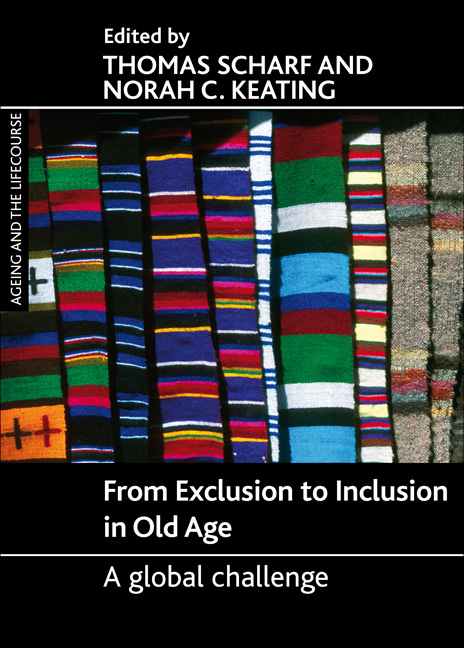Book contents
- Frontmatter
- Dedication
- Contents
- List of tables and figures
- Acknowledgements
- Notes on contributors
- Foreword
- one Social exclusion in later life: a global challenge
- two Globalisation, economic recession and social exclusion: policy challenges and responses
- three International migration: patterns and implications for exclusion in old age
- four Social inclusion of older people in developing countries: relations and resources
- five Exclusion from material resources: poverty and deprivation among older people in Europe
- six Social inclusion of elders in families
- seven The impact of changing value systems on social inclusion: an Asia-Pacific perspective
- eight Age discrimination as a source of exclusion in Europe: the need for a human rights plan for older persons
- nine Towards inclusive built environments for older adults
- ten Revisiting social exclusion of older adults
- Index
nine - Towards inclusive built environments for older adults
Published online by Cambridge University Press: 07 September 2022
- Frontmatter
- Dedication
- Contents
- List of tables and figures
- Acknowledgements
- Notes on contributors
- Foreword
- one Social exclusion in later life: a global challenge
- two Globalisation, economic recession and social exclusion: policy challenges and responses
- three International migration: patterns and implications for exclusion in old age
- four Social inclusion of older people in developing countries: relations and resources
- five Exclusion from material resources: poverty and deprivation among older people in Europe
- six Social inclusion of elders in families
- seven The impact of changing value systems on social inclusion: an Asia-Pacific perspective
- eight Age discrimination as a source of exclusion in Europe: the need for a human rights plan for older persons
- nine Towards inclusive built environments for older adults
- ten Revisiting social exclusion of older adults
- Index
Summary
Introduction
Much of the discussion of social exclusion highlighted in this book has emphasised macro issues that influence opportunities for older adults to experience full citizenship. Global patterns of changes in the political economy (Chapter Two), of adherence to strict rules of filial piety (Chapter Seven) and of widespread migration in the face of economic recession, political turmoil and natural disasters (Chapter Three), all point to risks of exclusion of older adults.
At a more micro level, the residential context is both immediate and important in shaping older adults’ ability to participate in society (Scharf et al, 2002, 2005). Given the evidence that a major portion of day-to-day living, caregiving, support for activities of daily living and participation in social and civic life by older adults takes place in or near their homes and neighbourhoods (Glass and Balfour, 2003), understanding the opportunities and constraints afforded by residences and neighbourhoods is central to the growing discourse about exclusion of older adults. Further, the residential and neighbourhood environments become increasingly salient to those older adults faced with multiple personal and social changes that may limit their daily activities to their immediate or nearby surroundings (Dobson and Gilroy, 2009; Wahl and Oswald, 2010). It is these older adults who may be at particularly high risk of isolation, especially those in advanced old age who spend the majority of their time in their homes (Baltes et al, 1999; Oswald and Wahl, 2005). The central argument of this chapter is that physical aspects of housing and the neighbourhood play an important role in facilitating or inhibiting social inclusion of older adults, especially those with physical and/or cognitive disabilities.
This chapter takes as its focus the built environment, including the residence of the older person and the neighbourhood that extends beyond the home. It is set within the research and policy literature in Western Europe and North America where much of the research on built environments of residences and neighbourhoods has occurred. Reflecting the major focus of research and policy development in Western nations, it is the urban environment that provides the main source of evidence for this chapter.
- Type
- Chapter
- Information
- From Exclusion to Inclusion in Old AgeA Global Challenge, pp. 145 - 162Publisher: Bristol University PressPrint publication year: 2012
- 1
- Cited by

